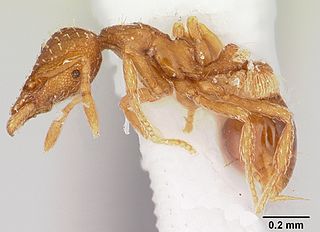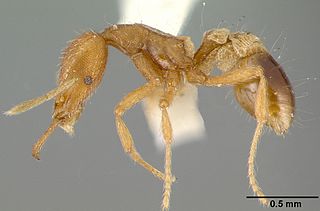| Strumigenys lichiaensis | |
|---|---|
| Scientific classification | |
| Kingdom: | Animalia |
| Phylum: | Arthropoda |
| Class: | Insecta |
| Order: | Hymenoptera |
| Family: | Formicidae |
| Subfamily: | Myrmicinae |
| Genus: | Strumigenys |
| Species: | S. lichiaensis |
| Binomial name | |
| Strumigenys lichiaensis Lin & Wu, 1996 | |
Strumigenys lichiaensis is a species of yellow ant up to 2.8 mm in length. It is endemic to Taiwan. [1]

Ants are eusocial insects of the family Formicidae and, along with the related wasps and bees, belong to the order Hymenoptera. Ants evolved from wasp-like ancestors in the Cretaceous period, about 140 million years ago, and diversified after the rise of flowering plants. More than 12,500 of an estimated total of 22,000 species have been classified. They are easily identified by their elbowed antennae and the distinctive node-like structure that forms their slender waists.

Endemism is the ecological state of a species being unique to a defined geographic location, such as an island, nation, country or other defined zone, or habitat type; organisms that are indigenous to a place are not endemic to it if they are also found elsewhere. The extreme opposite of endemism is cosmopolitan distribution. An alternative term for a species that is endemic is precinctive, which applies to species that are restricted to a defined geographical area.

Taiwan, officially the Republic of China (ROC), is a state in East Asia. Neighbouring states include the People's Republic of China (PRC) to the west, Japan to the northeast, and the Philippines to the south. Taiwan is the most populous state and largest economy that is not a member of the United Nations (UN).
This species can be distinguished from all Taiwanese congeners except Strumigenys liukueiensis by the numerous stout hairs on the dorsal surface of the mesosoma. It can be separated from S. liukueiensis by its considerably smaller size (workers only up to 2.2 mm in length). [1]
Strumigenys liukueiensis is a species of ant endemic to Taiwan.

The mesosoma is the middle part of the body, or tagma, of arthropods whose body is composed of three parts, the other two being the prosoma and the metasoma. It bears the legs, and, in the case of winged insects, the wings.

Eusociality, the highest level of organization of sociality, is defined by the following characteristics: cooperative brood care, overlapping generations within a colony of adults, and a division of labor into reproductive and non-reproductive groups. The division of labor creates specialized behavioral groups within an animal society which are sometimes called castes. Eusociality is distinguished from all other social systems because individuals of at least one caste usually lose the ability to perform at least one behavior characteristic of individuals in another caste.






